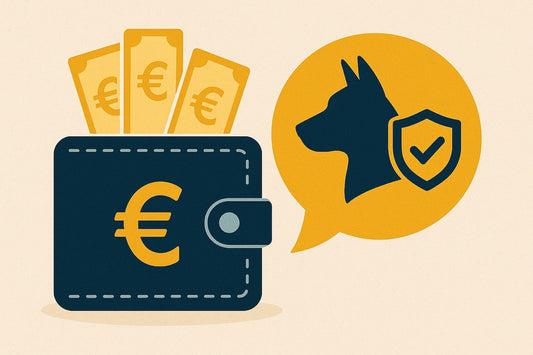Have you ever noticed your faithful companion running around in circles, chasing his own tail as if he were caught in a never-ending merry-go-round? This behavior, while sometimes amusing, can hide more serious problems. As a French bulldog owner living in the city, I have been confronted with this situation and I know how disconcerting it can be. Let's discover together the reasons why our four-legged friends bite their tails and the solutions to solve it.
The causes behind this intriguing canine behavior
When a dog bites its tail, it is not always a simple play. This gesture can be the symptom of various problems, ranging from benign to more worrying. Here are the main reasons that explain this behavior:
Natural Exploration in Puppies : It is completely normal for a young dog to explore his body. This curiosity is part of his development, but it should not persist into adulthood.
Attention seeking : Sometimes our four-legged friends use this behavior to get our attention. It's their way of saying, "Hey, pay attention to me!"
Unwanted parasites : Fleas, ticks or intestinal worms can cause intense itching, causing the dog to bite itself to relieve its discomfort.
Health problems : Skin infections, inflammation of the anal glands or even hormonal disorders can cause this behavior.
As a content creator who is passionate about French Bulldogs, I have noticed that certain breeds are more prone to this type of behavior. Here is a summary table of the predisposed breeds:
| Breed | Special predisposition |
|---|---|
| West Highland White Terrier | Skin allergies |
| Beagle | Anal gland problems |
| Springer Spaniel | Anxiety |
| Basset Hound | Skin infections |
| Cocker | Obsessive-compulsive disorder |
| Boxer | Hyperactivity |
It is crucial not to ignore this behavior, as it can quickly become a habit that is difficult to break and potentially dangerous to your pet's health.
Effective solutions to stop this behavior
When faced with a dog that bites its tail, it is imperative to act quickly and appropriately. Here are the steps to follow to solve this problem:
1. Veterinary consultation : This is the first thing to do. A professional will be able to identify the underlying cause and prescribe the appropriate treatment if necessary.
2. Targeted treatment : Depending on the diagnosis, it will be necessary to treat parasites, treat infections or manage allergies. For example, while walking my bulldogs, I noticed that one of them was chewing his tail frantically. A veterinary examination revealed a flea infestation which we quickly treated.
3. Physical protection : In some cases, the use of a collar may be necessary to prevent access to the tail while the treatment takes effect.
4. Mental and physical stimulation : Boredom is often a trigger. Increase play sessions and walks. Personally, I have seen a marked improvement in my dogs' behavior after introducing intelligence games into their daily routine.
Here is a list of stimulating activities for your dog:
- Search games with hidden treats
- Homemade obstacle course
- Learning new tricks
- Interactive toys
- Short but frequent training sessions
5. Stress Management : Identify sources of stress for your pet and try to minimize them. Soft music or calming pheromones can help.
Prevention is better than cure: tips to avoid recurrence
Once the problem has been resolved, it is essential to put preventative measures in place to prevent your dog from starting tail biting again. Here are some essential tips:
Regular flea treatments : Don't wait until you see fleas to take action. Monthly treatment is often recommended, especially for city-dwelling dogs like my French bulldogs.
Balanced diet : Quality nutrition strengthens the immune system and can prevent certain allergies. I personally opted for a premium diet adapted to the specific needs of my dogs, which has significantly improved their general condition.
Daily Exercise : A tired dog is a happy dog! Make sure your companion gets enough physical activity every day. As an entrepreneur, I have had to adjust my schedule to include regular walks, which has proven beneficial for both my dogs and myself.
Environmental Enrichment : Provide your dog with a stimulating environment with varied toys and mental challenges. This may include dog puzzles or short but frequent training sessions.
Socialization : Interaction with other dogs and humans is crucial for your pet's mental well-being. Set up dog playdates or frequent dog parks if your companion is social.
By implementing these tips, you will create an environment that is conducive to your dog's well-being, thereby reducing the risk of problem behaviors such as tail biting.
When the problem persists: the importance of professional follow-up
Sometimes, despite your best efforts, the problem may persist. In this case, do not hesitate to consult a canine behaviorist. These specialists can identify more subtle factors that you may have missed and offer tailor-made solutions.
As the owner of several French Bulldogs, I have learned the importance of patience and persistence. Each dog is unique and may respond differently to treatments and routine changes. Don't hesitate to keep a behavior journal to better track your dog's progress and share this information with professionals.
It is also crucial to understand that some dogs can develop obsessive-compulsive disorder . In these cases, an approach that combines behavioral therapy and sometimes medication may be necessary. Don't be discouraged if progress is slow; with the right support and lots of love, your companion can overcome this challenge.
Remember that your commitment to your dog’s well-being is the key to success. By remaining attentive, proactive, and working closely with animal health professionals, you can help your faithful friend return to a happy, balanced life, free from this annoying tail-biting behavior.







